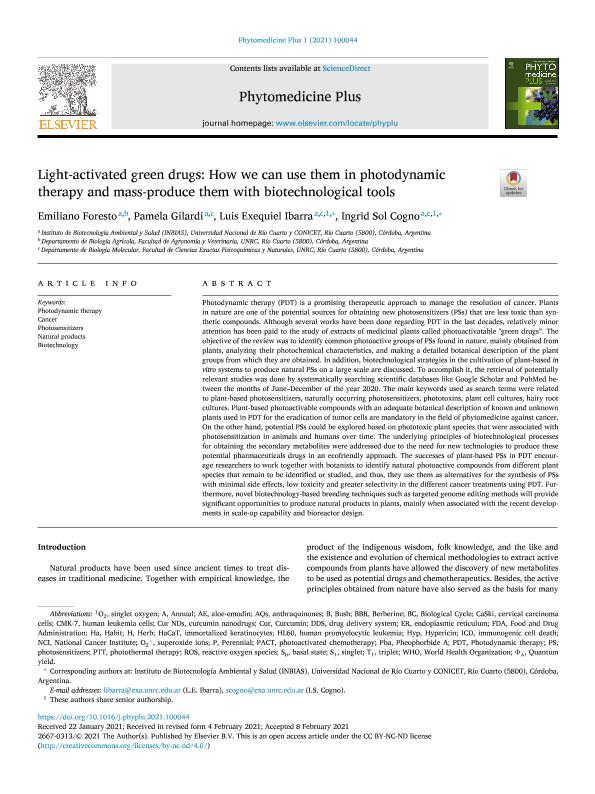Mostrar el registro sencillo del ítem
dc.contributor.author
Foresto, Emiliano

dc.contributor.author
Gilardi, Pamela
dc.contributor.author
Ibarra, Luis Exequiel

dc.contributor.author
Cogno, Ingrid Sol

dc.date.available
2022-12-26T17:45:40Z
dc.date.issued
2021-08
dc.identifier.citation
Foresto, Emiliano; Gilardi, Pamela; Ibarra, Luis Exequiel; Cogno, Ingrid Sol; Light-activated green drugs: How we can use them in photodynamic therapy and mass-produce them with biotechnological tools; Elsevier B.V.; Phytomedicine Plus; 1; 3; 8-2021; 1-16
dc.identifier.issn
2667-0313
dc.identifier.uri
http://hdl.handle.net/11336/182348
dc.description.abstract
Photodynamic therapy (PDT) is a promising therapeutic approach to manage the resolution of cancer. Plants in nature are one of the potential sources for obtaining new photosensitizers (PSs) that are less toxic than synthetic compounds. Although several works have been done regarding PDT in the last decades, relatively minor attention has been paid to the study of extracts of medicinal plants called photoactivatable "green drugs''. The objective of the review was to identify common photoactive groups of PSs found in nature, mainly obtained from plants, analyzing their photochemical characteristics, and making a detailed botanical description of the plant groups from which they are obtained. In addition, biotechnological strategies in the cultivation of plant-based in vitro systems to produce natural PSs on a large scale are discussed. To accomplish it, the retrieval of potentially relevant studies was done by systematically searching scientific databases like Google Scholar and PubMed between the months of June–December of the year 2020. The main keywords used as search terms were related to plant-based photosensitizers, naturally occurring photosensitizers, phototoxins, plant cell cultures, hairy root cultures. Plant-based photoactivable compounds with an adequate botanical description of known and unknown plants used in PDT for the eradication of tumor cells are mandatory in the field of phytomedicine against cancer. On the other hand, potential PSs could be explored based on phototoxic plant species that were associated with photosensitization in animals and humans over time. The underlying principles of biotechnological processes for obtaining the secondary metabolites were addressed due to the need for new technologies to produce these potential pharmaceuticals drugs in an ecofriendly approach. The successes of plant-based PSs in PDT encourage researchers to work together with botanists to identify natural photoactive compounds from different plant species that remain to be identified or studied, and thus, they use them as alternatives for the synthesis of PSs with minimal side effects, low toxicity and greater selectivity in the different cancer treatments using PDT. Furthermore, novel biotechnology-based breeding techniques such as targeted genome editing methods will provide significant opportunities to produce natural products in plants, mainly when associated with the recent developments in scale-up capability and bioreactor design.
dc.format
application/pdf
dc.language.iso
eng
dc.publisher
Elsevier B.V.
dc.rights
info:eu-repo/semantics/openAccess
dc.rights.uri
https://creativecommons.org/licenses/by-nc-sa/2.5/ar/
dc.subject
BIOTECHNOLOGY
dc.subject
CANCER
dc.subject
NATURAL PRODUCTS
dc.subject
PHOTODYNAMIC THERAPY
dc.subject
PHOTOSENSITIZERS
dc.subject.classification
Ciencias de las Plantas, Botánica

dc.subject.classification
Ciencias Biológicas

dc.subject.classification
CIENCIAS NATURALES Y EXACTAS

dc.title
Light-activated green drugs: How we can use them in photodynamic therapy and mass-produce them with biotechnological tools
dc.type
info:eu-repo/semantics/article
dc.type
info:ar-repo/semantics/artículo
dc.type
info:eu-repo/semantics/publishedVersion
dc.date.updated
2022-09-20T18:36:18Z
dc.journal.volume
1
dc.journal.number
3
dc.journal.pagination
1-16
dc.journal.pais
Alemania

dc.journal.ciudad
Berlin
dc.description.fil
Fil: Foresto, Emiliano. Universidad Nacional de Rio Cuarto. Facultad de Cs.exactas Fisicoquimicas y Naturales. Instituto de Biotecnologia Ambiental y Salud. - Consejo Nacional de Investigaciones Cientificas y Tecnicas. Centro Cientifico Tecnologico Conicet - Cordoba. Instituto de Biotecnologia Ambiental y Salud.; Argentina. Universidad Nacional de Río Cuarto. Facultad de Agronomía y Veterinaria; Argentina
dc.description.fil
Fil: Gilardi, Pamela. Universidad Nacional de Rio Cuarto. Facultad de Cs.exactas Fisicoquimicas y Naturales. Instituto de Biotecnologia Ambiental y Salud. - Consejo Nacional de Investigaciones Cientificas y Tecnicas. Centro Cientifico Tecnologico Conicet - Cordoba. Instituto de Biotecnologia Ambiental y Salud.; Argentina. Universidad Nacional de Rio Cuarto. Facultad de Cs.exactas Fisicoquimicas y Naturales. Instituto de Biotecnologia Ambiental y Salud. - Consejo Nacional de Investigaciones Cientificas y Tecnicas. Centro Cientifico Tecnologico Conicet - Cordoba. Instituto de Biotecnologia Ambiental y Salud.; Argentina
dc.description.fil
Fil: Ibarra, Luis Exequiel. Universidad Nacional de Río Cuarto. Facultad de Ciencias Exactas Fisicoquímicas y Naturales. Departamento de Biología Molecular; Argentina. Universidad Nacional de Rio Cuarto. Facultad de Cs.exactas Fisicoquimicas y Naturales. Instituto de Biotecnologia Ambiental y Salud. - Consejo Nacional de Investigaciones Cientificas y Tecnicas. Centro Cientifico Tecnologico Conicet - Cordoba. Instituto de Biotecnologia Ambiental y Salud.; Argentina
dc.description.fil
Fil: Cogno, Ingrid Sol. Universidad Nacional de Rio Cuarto. Facultad de Cs.exactas Fisicoquimicas y Naturales. Instituto de Biotecnologia Ambiental y Salud. - Consejo Nacional de Investigaciones Cientificas y Tecnicas. Centro Cientifico Tecnologico Conicet - Cordoba. Instituto de Biotecnologia Ambiental y Salud.; Argentina. Universidad Nacional de Río Cuarto. Facultad de Ciencias Exactas Fisicoquímicas y Naturales. Departamento de Biología Molecular; Argentina
dc.journal.title
Phytomedicine Plus
dc.relation.alternativeid
info:eu-repo/semantics/altIdentifier/url/https://linkinghub.elsevier.com/retrieve/pii/S2667031321000269
dc.relation.alternativeid
info:eu-repo/semantics/altIdentifier/doi/https://doi.org/10.1016/j.phyplu.2021.100044
Archivos asociados
